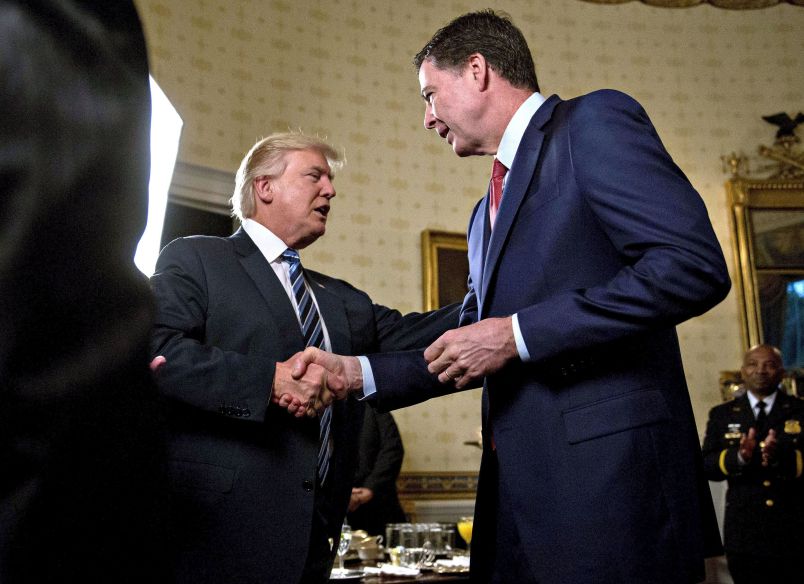Let me share a few more thoughts about yesterday evening’s breaking news about President Trump’s overtures to the head of the NSA and the Director of National Intelligence.
Given what we knew already, these new details cannot be terribly surprising. Indeed, they fit a clear pattern. But they show just how far-reaching, widespread and brazen President Trump was in trying to shut down the investigation into his campaign and Russia.
We know from Comey’s accounts that Trump repeatedly tried to get pledges of loyalty from Comey. He purportedly asked Comey privately to drop the investigation the day after he fired Flynn. Of course, Trump eventually fired Comey, by his own account over frustration with the Russian probe. Now we learn that after Comey’s March testimony in which the FBI Director first confirmed the existence of a collusion/coordination probe, Trump personally reached out to Admiral Rodgers at NSA and Director of National Intelligence Dan Coats to push back against or dispute Comey’s revelation.
Both apparently politely demurred.
Some minor props here for Coats. The former Indiana Senator’s qualifications for this position were slim. He’s a career politician, not an intelligence professional, with the different political antennae and loyalties that go with being a career elected official. Unlike almost all the rest involved – Comey, Rodgers, et al., he’s in his position because of Trump. Yet he appears to have seen the overtures in the same light and similarly rebuffed Trump’s requests.
In many ways this is the most telling passage …
In addition to the requests to Coats and Rogers, senior White House officials sounded out top intelligence officials about the possibility of intervening directly with Comey to encourage the FBI to drop its probe of Michael Flynn, Trump’s former national security adviser, according to people familiar with the matter. The officials said the White House appeared uncertain about its power to influence the FBI.
“Can we ask him to shut down the investigation? Are you able to assist in this matter?” one official said of the line of questioning from the White House.
There’s a lot here.
It appears that Trump and his top advisors were increasingly concerned that they could not get through to Comey to drop the investigation. They then started reaching out to others in the intelligence community either to publicly rebut Comey’s statements or try to intervene with him directly.
First, let’s consider what appears to have been the extreme importance Trump and his advisors attached to ending the Flynn/Trump-Russia probes. We’re focused on the loyalty pledge and Comey’s ouster. But they apparently tried every means they could think of to shut down the probe, all of them widely in appropriate and others quite possibly illegal.
Second, look at Trump’s personal role. Even if a President or White House has decided to obstruct or shut down an investigation, this is not the way to execute the plan. Put in the most cynical possible way, the President should never have been personally made these calls, implicating himself directly in the effort. These kinds of overtures are made their advisors and hopefully with some ambiguity and thus deniability.
Nor should Trump have called these men, apparently in their offices, where they could write perhaps literally contemporaneous notes of the conversations. It’s hard to unwrap what measure of this was desperation, recklessness or Trump’s complete unfamiliarity and inability to understand that all of these men were not executives in a private company run by him but high level officials in a government in which the President is the dominant but by not means only power center.
To get our collective heads around this, we must take note of this complexity and yet keep it simple: The President desperately wants to shut down the Trump-Russia probe and is going to the wildest and riskiest lengths to end it. The unique dynamics of Trumpian psychology make it just plausible that rather than a consciousness of guilt or fear, he is driven here by a need to brook no opposition or a fear that any discussion of this issue detracts from his “legendary triumph” last November, as Turkish President Erdogan put it.
But there’s a more straightforward explanation, even for Trump: a consciousness of guilt, if not necessarily his than those close around him, whose transgressions would rub off on him. There is of course my “Mailer Standard” theory: that Trump actually doesn’t know what investigators will find but has every reason to think it won’t be good. Simple: President must end the investigation because he can’t allow them to find what’s there.
We’re far past any question of a cover-up or an attempt to kill the investigation. We have almost too much evidence, too many positive acts. It’s like Trump is still operating in a reality show, where every positive act is devoid of subtlety, infinitely direct so as to move the plot-line forward in the length of a single episode and ubiquitously recorded so we can see it all playing out before our eyes.






